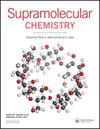喹啉空腔和筐的合成
IF 2.6
4区 化学
Q3 CHEMISTRY, MULTIDISCIPLINARY
引用次数: 1
摘要
独特的温度,溶剂和pH驱动的花瓶在喹啉空腔体中保持平衡,允许可逆的吸收和释放来访者。然而,与这种构象转换相关的腔呼吸降低了络合的强度。已经提出了有限数量的解决方案的空腔硬化,使用氢键,金属配位或共价连接。在这里,我们报告了基于喹诺啉的空腔和筐的合成和结构表征,其中两个远端喹诺啉壁连接在一起。筐A和筐B是通过桥接反应得到的,桥接反应从AC二喹啉桥接腔开始,并使用两种不同的二喹啉基团。在这两种情况下,得到了两种异构体:异构体C2,连接单元穿过腔口,和异构体Cs,具有横向连接。通过核磁共振氢谱分析对异构体进行了鉴定。在筐A-Cs的情况下,分解的分子结构证实了筐的Cs对称性。Grapical文摘本文章由计算机程序翻译,如有差异,请以英文原文为准。
Synthesis of quinoxaline cavitand baskets
ABSTRACT The unique temperature, solvent and pH drivenvase to kite equilibrium in quinoxaline cavitands allows the reversible uptake and release of guests. However, the cavity breathing associated with this conformational switch reduces the strength of complexation. A limited number of solutions have been proposed for the cavity rigidification, using either H-bonding, metal coordination or covalent connections. Here we report the synthesis and structural characterisation of quinoxaline-based cavitand baskets, which present two distal quinoxaline walls linked together. Baskets A and B were obtained through a bridging reaction starting from an AC di-quinoxaline bridged cavitand using two different di-quinoxaline moieties. In both cases, two isomers were obtained: isomer C2, with the linking unit crossing the cavity mouth, and isomer Cs, having the linker sideways. The isomers were identified through 1H NMR analysis. In the case of basket A-Cs, the resolved molecular structure confirmed the Cs symmetry of the basket. Grapical abstract
求助全文
通过发布文献求助,成功后即可免费获取论文全文。
去求助
来源期刊

Supramolecular Chemistry
化学-化学综合
CiteScore
3.60
自引率
3.00%
发文量
5
审稿时长
2.7 months
期刊介绍:
Supramolecular Chemistry welcomes manuscripts from the fields and sub-disciplines related to supramolecular chemistry and non-covalent interactions. From host-guest chemistry, self-assembly and systems chemistry, through materials chemistry and biochemical systems, we interpret supramolecular chemistry in the broadest possible sense. Interdisciplinary manuscripts are particularly encouraged. Manuscript types include: high priority communications; full papers; reviews, and; Methods papers, techniques tutorials highlighting procedures and technologies that are important to the field. We aim to publish papers in a timely fashion and as soon as a paper has been accepted and typeset it will be published in electronic form on the Latest articles section of the website. The two most important review criteria are that the paper presents high-quality work that fits generally into the broad spectrum of activities in the supramolecular chemistry field. Under normal circumstances, Supramolecular Chemistry does not consider manuscripts that would be more suitable in a highly specialized journal. This includes, but is not limited to, those based mostly or exclusively on topics such as solid state/X-ray structures, computational chemistry, or electrochemistry. .
The two most important review criteria are that the paper presents high-quality work that fits generally into the broad spectrum of activities in the supramolecular chemistry field.
 求助内容:
求助内容: 应助结果提醒方式:
应助结果提醒方式:


